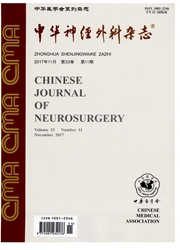

 中文摘要:
中文摘要:
目的 总结分析颅脑损伤伴发颅内感染患者的临床特点和急性期预后的相关因素.方法 选择2008年1月至2012年12月复旦大学附属华山医院外伤中心收治的经脑脊液培养证实颅内感染的颅脑损伤患者,分析出院时格拉斯哥昏迷评分(GCS)、多菌种以及G-/G+菌感染的影响因素.结果 共有82例颅脑损伤患者并发颅内感染.检出细菌97株,最主要的致病菌是鲍曼不动杆菌,占所有病原菌的28.9%.入院时GCS评分(OR:7.44,95% CI:2.80 ~ 19.76,P<0.0001)、脑室外引流术(OR:0.31,95% CI:0.12 ~0.79,P=0.0220)、G-菌感染(OR:0.21,95% CI:0.07~0.62,P=0.0062)以及肺炎(OR:0.33,95% CI:0.12 ~0.85,P=0.0352)是影响出院时GCS评分的重要因素;院内病死率在G-和G+菌感染组间差异有统计学意义(OR:10.95,95% CI:0.6234~192.2,P=0.0327);单菌和多菌种感染组、总住院费差异有统计学意义(P=0.0347).结论 入院时GCS评分低、脑室外引流术、G-菌感染和肺炎是出院时GCS评分低的高危因素,其中G菌感染还是发生院内死亡的高危因素.对有高危因素的患者应给予积极有效地治疗,以降低病死率和病残率.
 英文摘要:
英文摘要:
Objective To summary and analyze the clinical characteristics and acute phase prognosis of brain injury patients complicated by intracranial infection.Methods The clinical data of brain injury patients with intracranial infection confirmed by cerebrospinal fluid culture in Huashan hospital trauma center during January 2008 to December 2012 were collected and retrospectively analyzed.Risk factors of Glasgow coma scale (GCS) at discharge,multiple microbial infection and G-/G+ infection were investigated.Results From January 2008 to December 2012 there are 82 patients with intracranial infection secondary to brain injury.Total of 97 bacterial strains were identified by CSF culture,of which A.Baumannii was the most common pathogenic bacteria (28.9%).GCS at admission (OR:7.44,95% CI:2.80-19.76,P <0.0001),extra-ventricular drainage(EVD) (OR:0.31,95% CI:0.12-0.79,P =0.0220),G-infection (OR:0.21,95% CI:0.07-0.62,P =0.0062) and pneumonia (OR:0.33,95% CI:0.12-0.85,P =0.0352) were the main risk factors for poor GCS at discharge; there was significant difference in in-hospital mortality (OR:10.95,95% CI:0.6234-192.2,P =0.0327) between G-and G + bacterial infectious group; hospital expense was higher in patients with intracranial infections caused by multiple bacterial species than that caused by single bacterial species (P =0.0347).Conclusions Low GCS at admission,EVD,G infection and pneumonia were the risk factors associated with the low GCS at discharge.Intracranial infection caused by G bacterial was the high risk factor for inhospital mortality.Active treatment should be adopted for those patients at high risk to lower the mortality and morbidity,alleviating their financial burden.
 同期刊论文项目
同期刊论文项目
 同项目期刊论文
同项目期刊论文
 Effects and Clinical Characteristics of Intracranial Pressure Monitoring-Targeted Management for Sub
Effects and Clinical Characteristics of Intracranial Pressure Monitoring-Targeted Management for Sub Impact of intracranial pressure monitoring on mortality in patients with traumatic brain injury: a s
Impact of intracranial pressure monitoring on mortality in patients with traumatic brain injury: a s Continuous Measurement of the Cumulative Amplitude and Duration of Hyperglycemia Best Predicts Outco
Continuous Measurement of the Cumulative Amplitude and Duration of Hyperglycemia Best Predicts Outco 期刊信息
期刊信息
